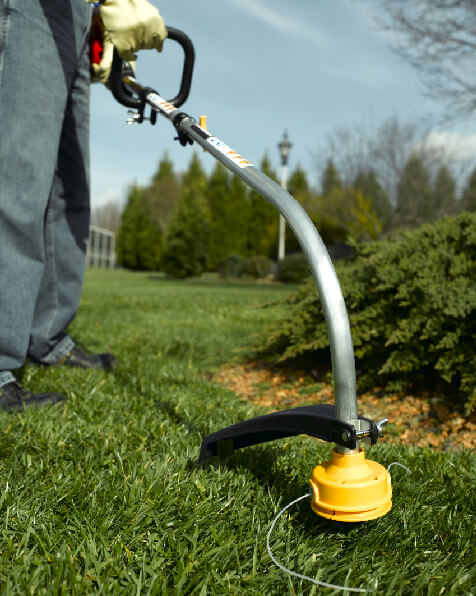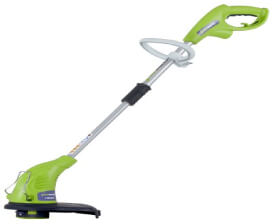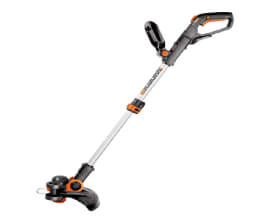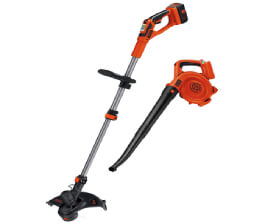Best Weed Eater Guide
Our Overview:
What is a Weed Eater?
Created by a man named George Ballas in Houston, the weed eater or string trimmer has come a long way since its inception. The weed eater is an all-encompassing trimmer designed to help manage irregular growths along a grassy surface (i.e. weeds). The idea is to make sure the robust monofilament lining is able to spin through the weed and trim it down to the desired level. The entire tool includes a long shaft and handle that ensures precise trimming can occur from start to finish.
It’s important to note the traditional weed eater was made to help maneuver around hard objects (i.e. decks, patios, sidewalks) without leaving a mess or missing a spot. This accurate gardening tool provides tremendous precision year-round and is able to work in tight corners without damaging anything along the way.
String Trimmers: What to Look For
With the best weed eater or string trimmer, it’s best to focus on specific features necessary to make the tool useful. The market is flooded with a variety of makes and models as each one promises to be the finest thing since sliced bread. However, users have to be careful as they scour through the market looking to filter out bad options and find something worth their time.
Here are some of the key qualities to look for while finding the best weed eater on the open market. This information will make it easier to find good options within minutes.
Power Output
Let’s begin with the power output.
The power output refers to the amount of power generated by the weed eater as soon as it turns on. For example, some weed eaters are able to provide 400-1,200 watts depending on the model. The weed eater is designed to maximize its efficiency with the help of a high-grade motor. This motor is built into the overall design and used as a launching pad to spin the actual gears. Once these gears are in action, the monofilament line is able to whir into action and cut through the excess weeds.
The reason power output remains an important feature to look out for has to do with performance requirements. The more power a weed eater is able to offer, the more a user can do while working around their yard. Sometimes, there are certain growths around the yard that are stubborn and can create quite the mess. This is where a high-powered gardening tool can push hard enough to cut right through the weed without requiring unnecessary effort.
This is why more and more users are looking towards the overall power production before investing in the best weed eaters. It’s become one of the keystone features for modern string trimmers.
Overall Efficiency
The perfect weed eater requires contemporary features to ensure its job is done properly. To make sure this is the case, manufacturers spend time assessing how “efficient” it is. This can relate to its power consumption metrics, power output (watts), durability, accuracy, or a combination of everything. Without a proper assessment of these metrics, the weed eater isn’t going to become the type of valued purchase users want in this day and age. As a result, more and more users are thinking about the overall efficiency of what’s being purchased.
For example, is the weed eater able to work well in all conditions? is it going to do well on uneven hills? Is it going to work well in wetter conditions?
The efficiency of a product such as this has to be sky-high for it to become a valued investment. Otherwise, it’s going to fall by the wayside as users don’t find it to be helpful over the long-term. It’s important to think about this feature while buying a new string trimmer. This is the only way to feel safe about what is being bought and how it’s going to work out.
Durability/Build Quality
The durability of a weed eater is going to hold weight when it’s time to find a high-grade model. In general, the average weed eater is made of robust gardening materials that are ideal for various environments including drier conditions. This ensures whether it’s a flat terrain or a hillside, everything is manageable as soon as the trimming commences.
The build quality is also going to depend on the company’s ability to back its product (i.e. warranty).
It’s important to focus on how long the weed trimmer is going to last as soon as it is put together. If the weed trimmer isn’t able to hold up as soon as the trimming begins, it’s not going to add value to the overall collection of gardening tools. The durability also involves the line mechanism as it has to be effective for the weed eater to function. If the line isn’t coming through as it is supposed to, the entire tool goes to waste and becomes unusable over the long-term.
This is why high standards are put on weed eaters to have robust line-feeding mechanisms from day one. This ensures the weed eater doesn’t fall apart as soon as the purchase is made.
Usability
The usability of a weed eater has to be taken into account while comparing options.
This can include its weight, dimensions, ergonomics, and everything else associated with general usability. If the gardening tool isn’t user-friendly, it becomes a wasteful option to have up your sleeves. Some of the best string trimmers on the market are able to offer performance, durability, and usability all wrapped into one profound package. This is why they are able to appeal to the masses and work in a vast array of scenarios without causing issues.
Usability can also refer to how well a weed eater works in certain conditions. For example, if the weed eater only works well in dry conditions, it’s not going to be as easy to manage and may even get in the way of what’s being trimmed. This can become a major hassle and that’s why it’s important to think about how usable something is before investing.
With weed eaters, there’s also a small concern with the line-feeding mechanism. In cases where it is manually setup, this can be an additional hassle the user has to deal with from time to time. All of these details need to be accounted for well in advance!
Price
One of the underrated details to look for in a string trimmer involves pricing. Yes, the price is a part of the package and has to be kept in mind before making a decision! While it doesn’t hold the same weight as power, durability, or even usability, for many people, this does become the most important factor in the end. This has a lot to do with budgeting and the world of string trimmers is truly diverse. This means there are small, cheap options available on the open market right alongside some of the most expensive trimmers. It’s all about finding one that is in your price range while still getting the features that matter most.
Remember, simply having a high price tag doesn’t mean a trimmer is good!
There are several cost-efficient models that do the same thing and offer better price tags. It always comes down to what you need.
Warranty
The warranty is often one of the final factors associated with a weed eater. In general, a high-quality weed eater isn’t going to pose too many issues along the way, but it’s important to have a backup safety net just in case. This is where a good warranty plan goes a long way. Each weed eater comes with a set warranty coverage setup that’s provided to help protect users from a faulty purchase.
The average weed eater is going to come with a more traditional 1-year warranty (parts and labor), however, certain brands do go above and beyond with regards to this aspect. They provide additional years based on what the user needs as some will offer 2-3 years on top of what’s already in place.
Weight
The weight of a trimmer isn’t going to be the first thing users think about but it does matter. In essence, each trimmer is going to be made of several different parts and each one is going to weigh differently. It’s not only about the overall weight but also how it’s spread out from top to bottom.
Sometimes, a lightweight trimmer can feel heavier because of weight distribution issues (i.e. it’s heavily weighted towards the head). This is why it’s best to look into how a weed eater is designed and how heavy it is in the hands.
For larger yards, this becomes a key point since no one wants to lug around a heavy trimmer all day long.
Electric, Battery Operated, or Gas?
The weed eater is more than a singular design that’s sold across the planet. In fact, it’s a diverse category with numerous innovations, intricacies, and features. This includes how the motor is powered. In some cases, you are going to see three unique options, which include electric-powered, battery-operated, and gas-powered motors.
Each trimmer has its own pros and cons, which is why it’s best to weigh each one before making a decision. Before going through these pros and cons, it’s important to note, each option has merits in the right situation and it always comes down to preference.
Electric
The electric weed eater is designed to work with a corded setup. This cord runs from the electric-powered trimmer straight into a valid outlet. The electricity is able to power the motor as long as the cord is attached to the outlet. In general, these trimmers settle in the 400-1,200 watts range in terms of power output.
Pros: Easy to Start, Ideal for Smaller Jobs, Consistent Power Generation
Cons: Limited Range, Unhelpful for Industrial Projects
These are the underlying pros and cons of an electric variation and what it can offer modern-day users. This can be a useful situation for residential owners with a small yard/lawn.
Battery Operated
Battery-operated trimmers have entered the market and created a new category within this segment of the market. These are ideal for small-level tasks where a simple weed eater can help speed up things in comparison to manual alternatives. The battery can vary in size and output but is often harnessed next to the motor.
Pros: Great Range, Lightweight
Cons: Inconsistent, Restricted to Battery’s Quality
In some cases, this can be the ideal situation for users looking for a simple, easy to use solution.
Gas
This is well-regarded as the most powerful and illustrious version of a weed eater and is often spotted around construction sites. Gas-powered trimmers are reliant on the use of fuel to help power the motor. As long as the fuel is present, the trimmer is fully functional and works well. There are several versions of this type of trimmer and it is widely regarded as a great option.
Pros: Ideal for Industrial Use, Tremendous Power Output, Consistent Power Generation, Long Range
Cons: Complicated Startup, Increased Wear and Tear
While it does take time to learn how to start it up, the gas-powered weed eater remains the industry-standard among professionals because of its power output and general quality.
It’s important to note each variation brings something unique to the table and it’s always going to depend on your needs. For some, the industry-grade qualities of a gas-powered weed eater will stand out while others may want a residential-friendly electric-powered version instead. This is why it’s important to look through each variation and select one based on your preferences. This is how a user is able to pick out a solution that’s going to work well around the clock and is going to provide the type of quality users dream of. This is what a great weed eater is supposed to do!
Performance and Function
The performance of a weed eater is essential. It’s reliant on the motor successfully powering the monofilament line and efficiently spinning through the excess weeds. Along with being efficient with how it cut through weeds, everything needs to be done consistently and as safely as possible. This is why the handle is constructed to provide an ergonomic fit for the average user. With the well-balanced handle and shaft, everything is kept manageable whether it’s cutting through large weeds or simply rounding out the corners along a winding pathway. This is where a fully functional weed eater makes a tremendous difference.
Features
There are specific features that differentiate weed eaters from each other. Users are highly recommended to weigh each feature based on their usage requirements before making a purchase. This will depend on the type of weeds being trimmed, range requirements, weight, and more. Everything has to fit and this begins with the right selection of features.
By choosing something that’s viable, successful, and in line with your requirements, it’s easier to manage excess weeds without having to worry about lingering issues.
Here are some of the most important weed eater features to compare while assessing the merits of a new product.
Auto Feed
The “auto feed” trimmer refers to the automated process associated with trimming. As soon as the trimming begins, the line will continue to be fed forward to ensure it cuts through the weeds as intended. This is a unique process that eliminates manual corrects to the actual trimming during your session.
As soon as the line starts to shorten, the trimmer knows it’s time to extend its line. This keeps things straightforward for the average user. However, it’s important to note the advancing mechanism can be halted and/or ruined by damaging the front of the trimmer (i.e. slamming it against the curb).
Fixed Line
The fixed line is a straightforward setup. This means it is designed to have a fixed amount that is going to be available to the user during their trimming session around the yard.
This is ideal for those that don’t want to deal with potential tangles that are associated with tradition line mechanisms.
Bump Feed
The “bump feed” weed eater is a unique variation and is commonly seen in this gardening tool. In general, the bump feed mechanism uses the application of force or bump to ensure the line continues to pop forward as soon as it runs out. For example, let’s imagine the trimming is occurring and all of a sudden the line comes to an end as naturally expected. In this case, a gentle bump of the front-facing head will ensure the line is pushed forward and made available again. This process continues until the overall line runs out and there’s nothing left to push forward. In these cases, the user will have to replace the line just like they would with a battery in their remote control.
A good example of this would also be a soap dispenser. Imagine the line to be liquid soap. You will press the small button to get a small amount of soap, but there comes a point when it runs out. This is when you refill the dispenser.
The bump feed mechanism is a unique one but it’s also popular.
Parts
Shaft
The shaft is used to reach forward and get to those crevices around your yard without bending. Instead of manual processes where you would bend down to take out weeds, this ensures everything is done while standing. The shaft is long enough to help reach out and get to those tight spots in seconds while maintaining full control.
Head
This is where the action takes place and it’s the most important part of a modern weed eater.
The head is where the motor is going to be housed as well as the monofilament line. The head is going to ensure everything is functional and working the way it is supposed to while removing weeds. While each weed eater is going to have its own set of features, the head remains an integral part of how it works.
This is also the part that is going to come in contact with the weeds when it’s time to trim away.
Price Range
While looking at the best weed eaters, customers will consider several variables including power, durability, consistency, and usability. However, the cost associated with a new weed eater is also going to be a valid part of the purchasing process.
In general, the average weed eater is going to come somewhere between $100-$600. However, it’s important to note this is a general estimate of how each model is priced and some of the newer innovations are able to push into the $1,000+ price range. In most cases, those models are reserved for industrial situations involving construction sites or large gardening companies.
Safety
Safety is an essential component of any modern gardening tool and it’s no different for weed eaters. In fact, several high-grade safety features are integrated into the designs of these tools. For example, the front end has a safety lock that is able to keep users safe if they were to press against the wrong item.
It’s important to maintain high safety standards when it comes to using a weed eater.
This is what it always comes down to when it comes to managing safety whether it involves safety gear or how it is used.
Final Thoughts
Finding a great weed eater is all about knowing what’s required and looking for specific features in line with your requirements. Whether it’s a gas-powered, electric-powered, or battery-operated version, each weed eater brings something unique to the table. It’s important to weigh all of these options and make the best possible decision based on your needs. For some, this is going to include a weed eater that is able to cover long distances, while others want as much power as they can fit into the gardening tool. As the standards continue to rise, it’s become imperative to look into these details before making a final purchase.
Whatever your needs, find the perfect weed eater for you with our reviews.






